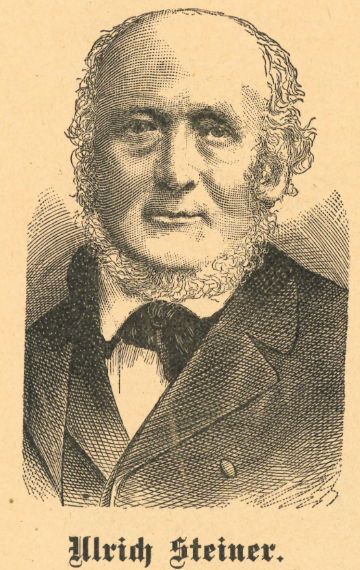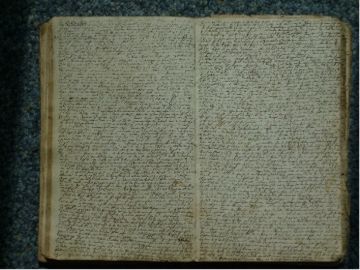Skandal oder Wunder? - Scandal or miracle?
In 1877, the Reformed pastor Mauerhofer from Lauperswil stood at the grave of the deceased Anabaptist teacher Ulrich Steiner from Emmental. And what did he do? He honored him as an impressive role model in life and faith: He, whom the Bernese authorities had imprisoned and fined several times before...
Ulrich Steiner (1806-1877) came from the Hämlismatt farm in Heimisbach (Trachselwald), and later moved to the Badertschen farm in the municipality of Lauperswil. Ulrich Steiner grew up in the Reformed church, but then joined the Anabaptist congregation in 1825. Already around 1830 he was elected preacher, in 1834 he married Elisabeth Wüthrich of Trub, and only one year later he was elected elder in 1835 - shortly after the church split due to the departure of some members to the "Neutäufer " (New Anabaptists).[1]

Ulrich Steiner (1806-1877) Anonymous portrait (in: Mennonitischer Gemeinde-Kalender 1906).
The times of the most severe persecution were fortunately over since the abolition of the Bernese Anabaptist chamber in 1743. And with the French Revolution, the Anabaptist communities in the Emmental had also felt a little more "liberté - égalité - fraternité". But phases of repression were by no means completely over. In 1811, 26 children from Anabaptist families were still baptized by force in Langnau. Ulrich Steiner was also punished with fines and imprisonment on several occasions for "violating the proselyte ban" of 1823, but was acquitted and rehabilitated after protests.
His offense was that the church baptism classes he gave to young people from the Anabaptist community were apparently so attractive that young people from Reformed churches also liked to attend them - and that Steiner allowed this. The "Neutäufer" movement, which arose in 1832 in the context of the revival movement, was subject to even stronger repression.
Ulrich Steiner seems to have been respected and appreciated far beyond Anabaptist circles because of his forceful and heartfelt preaching, as well as his gentle character aiming at balance and reconciliation.
He is the author of several letters and edifying writings.[2] He became known mainly as the author of the book "Pleasant Hours in Zion", of which even a translation into English had been arranged.[3]
An impressive sign that even among the churches in the Emmental the former opposition was gradually giving way to cooperation occurred at Ulrich Steiner's funeral in Lauperswil: The Reformed pastor Mauerhofer praised the late Anabaptist preacher as an impressive role model in faith and life.

Example of a closely written double page from the manuscript of Ulrich Steiner in the archive of the Swiss Association for Anabaptist History, Bienenberg / Liestal) (Foto HPJ)
[1] For the history of the emergence of the Neutäufer community in Emmental, cf. the adjacent short biography of Samuel H. Fröhlich. For further details see Bernhard Ott, Neues Licht auf die Entstehung der "Neutäufer". Die Trennung der Neutäufer von den Alttäufern im Emmental im Lichte der schriftlichen Aufzeichnungen von Samuel Heinrich Fröhlich, in Mennonitica Helvetica 18 (1995), 69-90. In Switzerland there are currently two different "Neutäuferische" congregational associations. The more open group is united in the Bund Evangelischer Täufer-Gemeinden ETG (Federation of Evangelical Anabaptist Congregations), while the more closed group has no distinct organizational structure and lives a very secluded life, without contact with other churches.
[2] Hanspeter Jecker, Alte Handschrift – neu entdeckt. «Kurze Betrachtung» des Emmentaler Ältesten Ulrich Steiner (1806–1877), in: Mennonitica Helvetica 41 (2018), 139-142.
[3] Cf. also Samuel Geiser, Art. "Steiner, Ulrich (1806–1877)." In: Global Anabaptist Mennonite Encyclopedia Online. 1959. gameo.org/Ulrich Steiner (Zugriff 2.12.2018).



